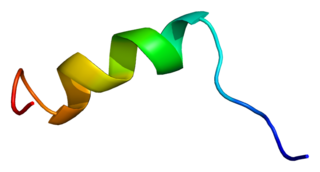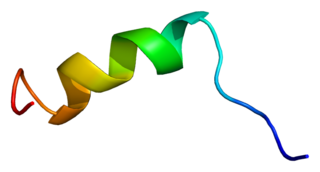Sodium channel protein type 1 subunit alpha (SCN1A), is a protein which in humans is encoded by the SCN1A gene. [5] [6] [7] [8]
Sodium channel protein type 1 subunit alpha (SCN1A), is a protein which in humans is encoded by the SCN1A gene. [5] [6] [7] [8]
The SCN1A gene is located on chromosome 2 of humans, and is made up of 26 exons spanning a total length of 6030 nucleotide base pairs. [9] [10] Alternative splicing of exon 5 gives rise to two alternate exons. [11] SCN1A contains a poison exon within intron 20. [12] The promoter has been identified 2.5 kilobase pairs upstream of the transcription start site, and the 5'- untranslated exons may enhance expression of the SCN1A gene in SH-SY5Y cells, a human cell line derived from a neuroblastoma. [13]
The vertebrate sodium channel is a voltage-gated ion channel essential for the generation and propagation of action potentials, chiefly in nerve and muscle. Voltage-sensitive sodium channels are heteromeric complexes consisting of a large central pore-forming glycosylated alpha subunit and 2 smaller auxiliary beta subunits. Functional studies have indicated that the transmembrane alpha subunit of the brain sodium channels is sufficient for expression of functional sodium channels. [14] Brain sodium channel alpha subunits form a gene subfamily with several structurally distinct isoforms clustering on chromosome 2q24, types I, II (Nav1.2), and III (Nav1.3). There are also several distinct sodium channel alpha subunit isoforms in skeletal and cardiac muscle (Nav1.4 [15] and Nav1.5, [16] respectively).
The SCN1A gene codes for the alpha subunit of the voltage-gated sodium ion channel making it a member of ten paralogous gene families which code for the voltage-gated sodium transmembrane proteins NaV1.1. Within the family of genes which code for other portions of voltage-gated sodium channels, the SCN1A mutations were the first identified, since mutations to this gene caused epilepsy and febrile seizures. [17] Indeed, the SCN1A gene is one of the most commonly mutated genes in the human genome associated with epilepsy, which has given it the title of a 'super culprit gene'. [18] There are 900 distinct mutations reported for the SCN1A gene, approximately half of the reported mutations are truncations which result in no protein. [19] [20] The remaining half of mutations are missense mutations, which are predicted to either cause loss-of-function or gain-of-function, though very few have been tested for functionality in the lab. [9]
Subtle differences in voltage-gated sodium ion channels can have devastating physiological effects and underlie abnormal neurological functioning. [21] [22] Mutations to the SCN1A gene most often result in different forms of seizure disorders, the most common forms of seizure disorders are Dravet Syndrome (DS), Intractable childhood epilepsy with generalized tonic-clonic seizures (ICEGTC), and severe myoclonic epilepsy borderline (SMEB). [19] Clinically, 70-80% of patients with DS have identified mutations specific to the SCN1A gene, which are caused by de novo heterozygous mutations of the SCN1A gene. [23] There are currently two databases on SCN1A mutations. [24] [25]
Mice with knock-in SCN1A mutations, who are model organisms for DS quickly develop seizures, indicative of a significant reduction in the function of NaV1.1. [10] It has been hypothesized that reduced sodium currents due to NaV1.1 mutations may cause hypoexcitability in GABAergic inhibitory interneurons leading to epilepsy. [13] Mice in both the homozygous and heterozygous states develop the seizure phenotype and ataxia. Though homozygous mice die on average during the second to third week of life and approximately 50% of heterozygous null mice survive into adulthood. [10] [13] [26]
Mutations in the SCN1A gene cause inherited febrile seizures, GEFS+, type 2, and Dravet syndrome. [27] [28] [29] [30]
On 29 November 2008, The Sydney Morning Herald reported the first evidence of private intellectual property rights over human DNA [31] having adversely affected medical care. The Melbourne company Genetic Technologies (GTG) controls rights to the gene, and requires royalties for tests on the gene, which can help identify Dravet syndrome. Doctors on the Children's Hospital in Westmead, Australia have told journalists that they would test 50% more infants for the gene, if they could conduct the test on site.
Nav1.1 has been shown to interact with syntrophin, alpha 1. [32]

Sodium channels are integral membrane proteins that form ion channels, conducting sodium ions (Na+) through a cell's membrane. They belong to the superfamily of cation channels.
Generalized epilepsy with febrile seizures plus (GEFS+) is a syndromic autosomal dominant disorder where affected individuals can exhibit numerous epilepsy phenotypes. GEFS+ can persist beyond early childhood. GEFS+ is also now believed to encompass three other epilepsy disorders: severe myoclonic epilepsy of infancy (SMEI), which is also known as Dravet's syndrome, borderline SMEI (SMEB), and intractable epilepsy of childhood (IEC). There are at least six types of GEFS+, delineated by their causative gene. Known causative gene mutations are in the sodium channel α subunit genes SCN1A, an associated β subunit SCN1B, and in a GABAA receptor γ subunit gene, in GABRG2 and there is another gene related with calcium channel the PCDH19 which is also known as Epilepsy Female with Mental Retardation. Penetrance for this disorder is estimated at 60%.
Dravet syndrome (DS), previously known as severe myoclonic epilepsy of infancy (SMEI), is an autosomal dominant genetic disorder which causes a catastrophic form of epilepsy, with prolonged seizures that are often triggered by hot temperatures or fever. It is very difficult to treat with anticonvulsant medications. It often begins before one year of age, with six months being the age that seizures, characterized by prolonged convulsions and triggered by fever, usually begin.

Sodium channel protein type 4 subunit alpha is a protein that in humans is encoded by the SCN4A gene.

Sodium channel protein type 5 subunit alpha, also known as NaV1.5 is an integral membrane protein and tetrodotoxin-resistant voltage-gated sodium channel subunit. NaV1.5 is found primarily in cardiac muscle, where it mediates the fast influx of Na+-ions (INa) across the cell membrane, resulting in the fast depolarization phase of the cardiac action potential. As such, it plays a major role in impulse propagation through the heart. A vast number of cardiac diseases is associated with mutations in NaV1.5 (see paragraph genetics). SCN5A is the gene that encodes the cardiac sodium channel NaV1.5.
Idiopathic generalized epilepsy (IGE) is a group of epileptic disorders that are believed to have a strong underlying genetic basis. IGE is considered a subgroup of Genetic Generalized Epilepsy (GGE). Patients with an IGE subtype are typically otherwise normal and have no structural brain abnormalities. People also often have a family history of epilepsy and seem to have a genetically predisposed risk of seizures. IGE tends to manifest itself between early childhood and adolescence although it can be eventually diagnosed later. The genetic cause of some IGE types is known, though inheritance does not always follow a simple monogenic mechanism.
Juvenile myoclonic epilepsy (JME), also known as Janz syndrome or impulsive petit mal, is a form of hereditary, idiopathic generalized epilepsy, representing 5–10% of all epilepsy cases. Typically it first presents between the ages of 12 and 18 with myoclonic seizures. These events typically occur after awakening from sleep, during the evening or when sleep-deprived. JME is also characterized by generalized tonic–clonic seizures, and a minority of patients have absence seizures. It was first described by Théodore Herpin in 1857. Understanding of the genetics of JME has been rapidly evolving since the 1990s, and over 20 chromosomal loci and multiple genes have been identified. Given the genetic and clinical heterogeneity of JME some authors have suggested that it should be thought of as a spectrum disorder.

Sodium voltage-gated channel alpha subunit 9 is a sodium ion channel that, in humans, is encoded by the SCN9A gene. It is usually expressed at high levels in two types of neurons: the nociceptive (pain) neurons at the dorsal root ganglion (DRG) and trigeminal ganglion; and sympathetic ganglion neurons, which are part of the autonomic (involuntary) nervous system.
Paralytic is a gene in the fruit fly, Drosophila melanogaster, which encodes a voltage gated sodium channel within D. melanogaster neurons. This gene is essential for locomotive activity in the fly. There are 9 different para alleles, composed of a minimum of 26 exons within over 78kb of genomic DNA. The para gene undergoes alternative splicing to produce subtypes of the channel protein. Flies with mutant forms of paralytic are used in fly models of seizures, since seizures can be easily induced in these flies.

Sodium channel, voltage-gated, type XI, alpha subunit also known as SCN11A or Nav1.9 is a voltage-gated sodium ion channel protein which is encoded by the SCN11A gene on chromosome 3 in humans. Like Nav1.7 and Nav1.8, Nav1.9 plays a role in pain perception. This channel is largely expressed in small-diameter nociceptors of the dorsal root ganglion and trigeminal ganglion neurons, but is also found in intrinsic myenteric neurons.

Cav2.1, also called the P/Q voltage-dependent calcium channel, is a calcium channel found mainly in the brain. Specifically, it is found on the presynaptic terminals of neurons in the brain and cerebellum. Cav2.1 plays an important role in controlling the release of neurotransmitters between neurons. It is composed of multiple subunits, including alpha-1, beta, alpha-2/delta, and gamma subunits. The alpha-1 subunit is the pore-forming subunit, meaning that the calcium ions flow through it. Different kinds of calcium channels have different isoforms (versions) of the alpha-1 subunit. Cav2.1 has the alpha-1A subunit, which is encoded by the CACNA1A gene. Mutations in CACNA1A have been associated with various neurologic disorders, including familial hemiplegic migraine, episodic ataxia type 2, and spinocerebellar ataxia type 6.

Sodium channel protein type 2 subunit alpha, is a protein that in humans is encoded by the SCN2A gene. Functional sodium channels contain an ion conductive alpha subunit and one or more regulatory beta subunits. Sodium channels which contain sodium channel protein type 2 subunit alpha are sometimes called Nav1.2 channels.

Voltage-dependent L-type calcium channel subunit beta-4 is a protein that in humans is encoded by the CACNB4 gene.

Sodium channel subunit beta-1 is a protein that in humans is encoded by the SCN1B gene.

Sodium channel, voltage-gated, type III, alpha subunit (SCN3A) is a protein that in humans is encoded by the SCN3A gene.

Sodium channel protein type 8 subunit alpha also known as Nav1.6 is a membrane protein encoded by the SCN8A gene. Nav1.6 is one sodium channel isoform and is the primary voltage-gated sodium channel at each node of Ranvier. The channels are highly concentrated in sensory and motor axons in the peripheral nervous system and cluster at the nodes in the central nervous system.

Nax is a protein that in humans is encoded by the SCN7A gene. It is a sodium channel alpha subunit expressed in the heart, the uterus and in glial cells of mice. It has low similarity to all nine other sodium channel alpha subunits (Nav1.1–1.9).

Ankyrin-3 (ANK-3), also known as ankyrin-G, is a protein from ankyrin family that in humans is encoded by the ANK3 gene.
Epilepsy-intellectual disability in females also known as PCDH19 gene-related epilepsy or epileptic encephalopathy, early infantile, 9 (EIEE9), is a rare type of epilepsy that affects predominately females and is characterized by clusters of brief seizures, which start in infancy or early childhood, and is occasionally accompanied by varying degrees of cognitive impairment. The striking pattern of onset seizures at a young age, genetic testing and laboratory results, potential developmental delays or developmental regression and associated disorders, eases diagnosis.
Voltage-gated sodium channels (VGSCs), also known as voltage-dependent sodium channels (VDSCs), are a group of voltage-gated ion channels found in the membrane of excitable cells (e.g., muscle, glial cells, neurons, etc.) with a permeability to the sodium ion Na+. They are the main channels involved in action potential of excitable cells.
compilation of genetic variations in the SCN1A gene that alter the expression or function of Nav1.1
This article incorporates text from the United States National Library of Medicine, which is in the public domain.